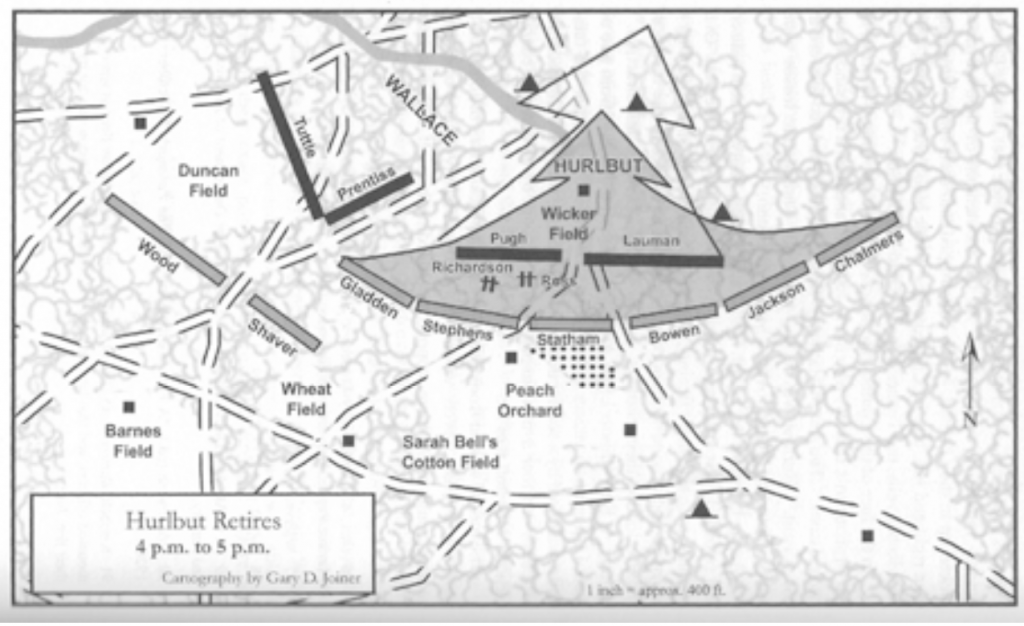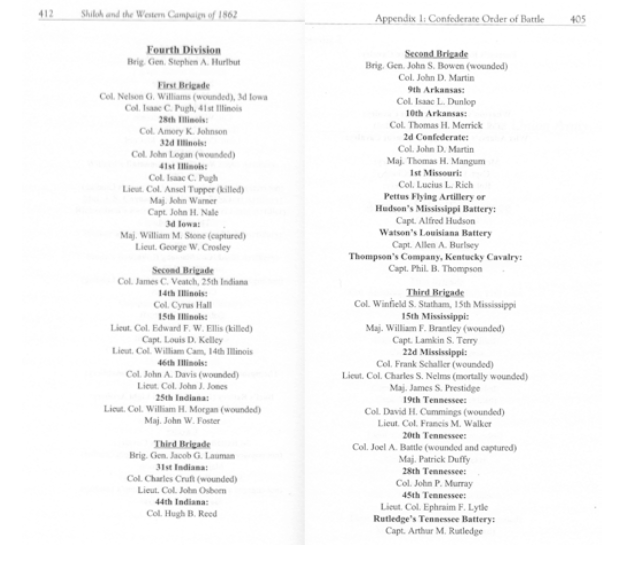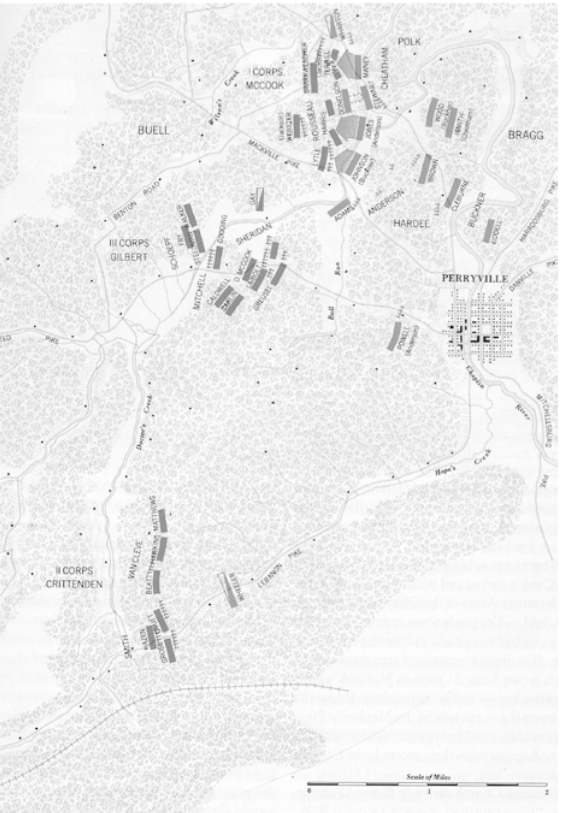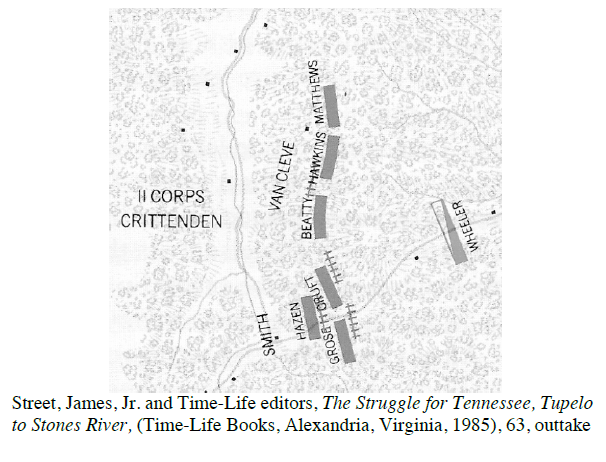In Blake’s Story, historic events bring two boys together, one of whom has killed the father of the other. In order for this to happen, the regiments in the story have to be in the right place at the right time. Here are the regiments and here are their relevant histories. Micah Bradford raised a company to support a friend of his in Tennessee. His company became part of the 19th Tennessee infantry regiment under Colonel David H. Cummings which, by the time of Shiloh, was within the Third Brigade under Colonel Winfield S. Stratham in the Reserve Corps of the Confederate Army under Brigadeer General John C. Breckinridge. Matthew Mills was a private in the 31st Indiana under Colonel Charles Cruft and, at Shiloh, in the Third Brigade under Brigadeer General Jacob G. Lauman within the Fourth Division of the Union Army under Brigadeer General Stephen A. Hurlbut. This is the map of events between four and five on the afternoon of April 7, 1862. Cunningham,

Cunningham, O. Edward, Shiloh and the Western Campaign of 1862 (Savas Beatie, New York. 2007), page 274
Note the location of Statham’s Regiment and Lauman’s regiment. The 19th was “on the right” [Cunningham, O. Edward, Shiloh and the Western Campaign of 1862 (Savas Beatie, New York. 2007), page 272]. Presumably, the 31st Indiana was on the right being listed first in the order of battle. This would put Micah and Matthew opposite each other at this point in the battle enabling Matthew to kill Blake’s father at this point.

Cunningham, O. Edward, Shiloh and the Western Campaign of 1862 (SavasBeatie, New York. 2007), pages 412/405
Note that the letter informing the family of Micah’s death is from Colonel Cummings.

Battle of Perryville, Kentucky, October 8, 1862 Street, James, Jr. and Time-Life editors, The Struggle for Tennessee, Tupelo to Stones River, (Time-Life Books, Alexandria, Virginia, 1985), 63
This sets the stage for the evolution of the second coming together of units so that Blake ends up in the same regiment as Matthew. When Blake runs away to the war, he ends up with the small company from the 2nd Tennessee Volunteer Infantry regiment, detached from General Benjamin J. Hill’s brigade of General Patrick R. Cleburne’s Division of General Kirby Smith’s army, as he hides in a wagon between Shelby and Greeneville. The supply company rejoins the army, operating in southeastern Kentucky and Blake finds himself replacing the drummer boy who has taken ill. For lack of a drum Blake rides courier for the regiment’s Colonel John A. Butler into battle at Richmond, Kentucky. Over the weeks that followed, Cleburne’s division was returned to General Braxton Bragg’s army as the two Confederate armies advanced toward Perryville, Kentucky. However, in the battle to come, the 31st Indiana of which Matthew was a soldier, would not be near the main battle. The 31st, under Charles Cruft was with General Thomas T. Crittenden and the II Corps on the Lebanon Pike, southwest of Perryville. The primary Confederate force on the Lebanon Pike was General Joseph Wheeler’s cavalry. As the 2nd Tennessee set camp with Bragg’s army, north of Perryville, events play out that see Blake assigned to Wheeler’s staff as a courier. The events involving Major General William Hardee and General Joseph Wheeler and their meeting before the battle, did take place. The history is real. When the battle began to unfold, Blake was with Wheeler and Matthew was with Cruft, under the overall command of General Crittenden.

Thus, as the story unfolds during the events of the battle at Perryville that play out on the Lebanon Pike, Blake falls wounded and is taken in by Matthew and John, thus saving him from possible death and putting the two boys together to allow the balance of the story to play out. Two historic events were critical to the historic accuracy of Blake’s Story. First, Matthew and Micah had to be at the same place at the same time during the battle at Shiloh for Matthew to kill Blake’s father. Second, Matthew and Blake had to be at the same place at the same time during the battle at Perryville for Blake to end up in the same unit with Matthew. This is the history that enables Blake’s Story, Revenge and Forgiveness, to unfold with historic truth. The rest of the history behind these regiments and their portrayal within Blake’s Story, can be found by reading the references gathered in the sources that follow.
Sources
2nd Tennessee Infantry Regiment (Bates), Google search and Wikipedia
http://freepages.genealogy.rootsweb.ancestry.com/~providence/cw_chap2.htm
http://www.tngenweb.org/civilwar/csainf/bates.html
Confederate Heartland Campaign Map American Civil War June to October 1862
http://americancivilwar.com/statepic/ky/ky009.html
http://americancivilwar.com/campaigns/Confederate_Heartland_Campaign.html
19th Tennessee Infantry Regiment, Google search and Wikipedia
http://en.wikipedia.org/wiki/19th_Tennessee_Infantry
http://www.tngenweb.org/civilwar/csainf/csa19.html http://dlc.lib.utk.edu/
spc/view?docId=tei/0012_003579_000201_0000/0012_003579_000201_0000.
xml;brand=default; http://www.civilwar.org/hallowed-ground-magazine/spring-
2010/preservingkentuckys-
battlefields.html
31st Indiana Infantry Regiment, Google search and Wikipedia
http://en.wikipedia.org/wiki/31st_Indiana_Infantry_Regiment
http://www.31stindiana.com/31hist.html
http://ehistory.osu.edu/exhibitions/Regimental/indiana/union/31stIndiana/history
Battle of Richmond, Kentucky, Google search and Wikipedia
http://en.wikipedia.org/wiki/Battle_of_Richmond http://www.ofsavagefury.com/
Battle of Perryville, Google search and Wikipedia
http://en.wikipedia.org/wiki/Battle_of_Perryville
http://www.civilwar.org/battlefields/perryville.html
http://www.battleofperryville.com/index.html
http://upload.wikimedia.org/wikipedia/commons/9/93/Perryville_1745.png
Cunningham, O. Edward, Shiloh and the Western Campaign of 1862 (New York,
Savas Beatie, 2007).
Confederate Heartland Offensive, Google search and Wikipedia
http://en.wikipedia.org/wiki/Confederate_Heartland_Offensive
http://www.ohiocivilwarcentral.com/entry.php?rec=183
http://www.mycivilwar.com/campaigns/620600.html
http://www.google.com/search?q=Confederate+Heartland+Offensive&ie=utf-
8&oe=utf-8&aq=t&rls=org.mozilla:en-US:official&client=firefox-a – 148 –
Darley, James M., Chief Cartographer, Melville Bell Grosvenor, Editor.
“Battlefields of the Civil War with descriptive notes,” Atlas Plate 14, April 1961.
Compiled and Drawn in the Cartographic Division of The National Geographic
Society for The National Geographic Magazine.
Despain, Karen, “Chino Valley woman finds trove of ancestor’s letters from Civil
War era,” The Daily Courier (Prescott Arizona, April 3, 2014).
Johnson,Robert Underwood and Clarence Clough Buel, editors, “Retreat From
Gettysburg,” Battles and Leaders of the Civil War Volume III (New York,
Thomas Yoselooff, 1956).
Nevin, David and Time-Life editors, The Road to Shiloh, Early Battles in the West
(Alexandria, Virginia, Time-Life Books, 1983).
Street, James, Jr. and Time-Life editors, The Struggle for Tennessee, Tupelo to
Stones River (Alexandria, Virginia, Time-Life Books, 1985).
